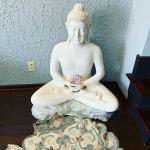Yunyan asked Daowu, ‘How does the Bodhisattva Guanyin use those many hands and eyes?’ Daowu answered, ‘It is like someone in the middle of the night reaching behind her head for the pillow.’ Yunyan said, ‘I understand.’ Daowu asked, ‘How do you understand it?’ Yunyan said, ‘All over the body are hands and eyes.’ Daowu said, ‘That is very well expressed, but it is only eight-tenths of the answer.’ Yunyan said, ‘How would you say it, Elder Brother?’ Daowu said, ‘Throughout the body are hands and eyes.’
Blue Cliff Record, Case 89
My Buddhism, or more accurately my Zen Buddhism, or most accurately my naturalistically oriented Zen Buddhism brings three things to my life. These are a coherent spiritual discipline, a philosophical ground upon which I stand, and beyond that a spiritual experience, which informs how I try to engage people and the world.
First, spiritual practice. I frequently summarize Zen practice as “sit down, shut up, and pay attention.” There are postures that support this discipline, which are sufficiently helpful some teachers in my tradition think they’re what its all about. And in a very important sense they’re right. To get inside this practice one needs to deeply understand the term “just this.” If one engages this just this, if one surrenders all the ifs, ands, buts and on the other hands, and instead just drop into the moment, just for a moment, then the sages of the Zen way suggest heaven and earth can reconcile, and this suffering world can be healed.
Beyond that all I’m going to say here about this discipline is that it is a practice of clarification. It is a relentless watching, particularly a relentless watching of body and mind which opens us up in very interesting ways. Specifically it leads us to a place where our ideas of body and mind fall away. Through this encounter, through this miracle of human consciousness new perspectives are revealed.
This leads to what I called the philosophical ground, the great insight. In the Avatamsaka Sutra, a Buddhist text, which dates from about the dawn of the Common Era, and which has long association with the Zen schools, the Buddhist scholar Francis Cook describes something wonderful.
“Far away in the heavenly abode of the great god Indra, there is a wonderful net which has been hung by some cunning artificer in such a manner that it stretches out infinitely in all directions. In accordance with the extravagant tastes of deities, the artificer has hung a single glittering jewel in each ‘eye’ of the net, and since the net itself is infinite in dimension, the jewels are infinite in number. There hang the jewels, glittering like stars of the first magnitude, a wonderful sight to behold.
“If we now arbitrarily select one of these jewels for inspection and look closely at it, we will discover that in its polished surface there are reflected all the other jewels in the net, infinite in number. Not only that, but each of the jewels reflected in this one jewel is also reflecting all the other jewels, so that there is an infinite reflecting process occurring.”
This image is, of course, a metaphor. We can engage this as a lovely image and play out the various consequences of what it can mean. And there is power in such philosophical reflections. We can see it as a kind of creed, “this I believe.” I think this idea can be particularly helpful when I am most confused. There are times for simple plain rules, and this one is straight ahead: we’re all in this mess together. From that, even when I have no idea what to do next, I at least feel I should try to be kind. If there were nothing more to it than this, it is a great gift.
But, in fact it is more than just a philosophical assertion with an implicit ethic. Or, at least so I suggest. But I believe it is this more that is the greatest gift the Buddhist perspective brings to us here in the West. The Zen master Bernie Glassman tells us “I define enlightenment as the depth to which one sees the oneness of life, the interconnectedness of life.” Then joined with that statement is a corollary. Bernie adds, intriguingly, tantalizingly, “And the degree of your enlightenment can be measured by your actions.”
Now the practice of presence, the practice of shutting up and paying attention, the practice of observing body and mind until the ideas of body and mind fall away, leads to a personal knowing of this world of intimacy, of our deepest interconnectedness, what Bernie calls our enlightenment, and which I prefer to call our awakening. As one Zen worthy put it, it is like taking a drink of water and knowing for yourself whether it is cool or warm.
And, this takes us to that last thing I spoke of; of those gifts Buddhism brings to Unitarian Universalism, and which we find in Bernie’s corollary to awakening – action. To explore that, let’s turn to that conversation between Yunyan and Daowu. This anecdote is preserved in the twelfth century anthology of Zen stories called the Blue Cliff Record, one of my favorite Zen documents. Actually I love it so much that our Southern California branch of Boundless Way Zen, which I guide, is named for it.
Both Yunyan and Daowu were students of the same teacher and would themselves each become famous teachers. According to some traditions they were actually brothers, but for various reasons this seems unlikely. More interesting to me is how Zen is organized in lineages; that is my teacher had a teacher who had a teacher, in a line that historically goes to early medieval China and mythically all the way back to the Buddha. For me a really interesting thing is how Yunyan is my teacher’s teacher’s teacher in an unbroken line running from my life back to the beginning of the ninth century.
But the really important thing for us is that both these monks had their ideas of self and other collapse and saw deeply into authentic interconnectedness. At the time this story takes place Daowu perhaps sees a bit deeper than his dharma brother. Although perhaps not. In the great way we play a lot, each of us taking different parts in turn, and play is in fact one of the primary spiritual disciplines. That noted, in this conversation we get a sense of what it means to move from the interdependent web as a really good idea, to where it describes who we actually are.
Now Guanyin is the archetype of compassion. Sometimes portrayed as a man, sometimes as a woman, occasionally in an androgynous form: but always as the deeply, profoundly felt impulse to reach out. This reaching out is the body of awakening. And Daowu says of this need to act, that it comes not through an interpretation of the image of the interdependent web, not through reading the Wealth of Nations, not through solid Marxist analysis, not through an investigation of Mary’s hymn in the Gospel According to Luke (although I suggest Mary is Guanyin), not through righteousness of any sort, certainly not righteous anger, a dreadful seducer beckoning us to a confusion of ends and means: but rather like someone turning in her sleep and reaching a hand behind her head to adjust her pillow.
Just this. Ends and means, one thing; our interdependence and you and I, one thing.
Now an old Zen saying has it that even the Buddha is continuing to practice. And understanding the relationship between our separate identities and the web itself is complex. So, Yunyan’s eighty percent is that this realization is like having eyes and hands all over our bodies. True, true, says his brother. But one hundred percent is that those eyes and hands are our body. No separation, however slight and the universal comes to be known the only place it can be known, in each particular instance, in each particular person.
So, this practice of refinement continues, and continues. And the path becomes one of ever greater intimacy. Each of us coming to know the other as we all walk the great way together constantly transformed and transforming.
It’s a simple as that.
And, as difficult…













